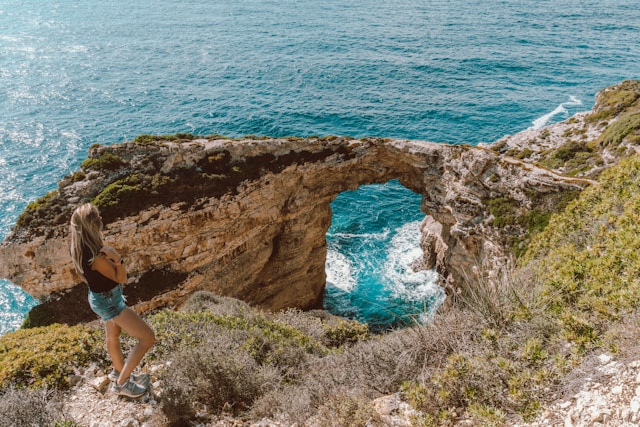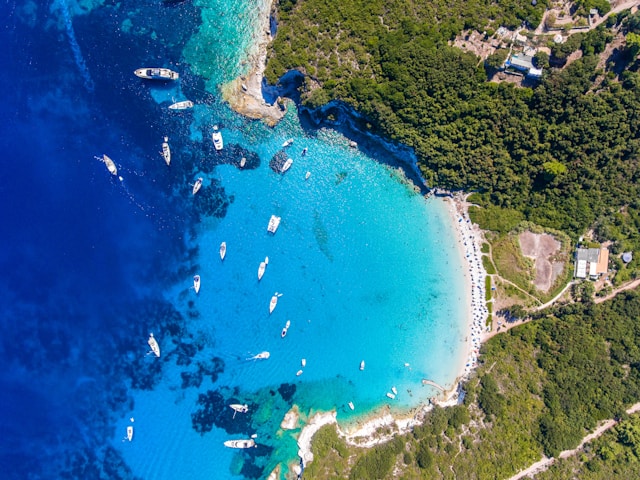All-in-One Guide To Paxos Greece
Despite its small size, Paxos is a famous and beautiful island in the Ionian Sea and is known for its beautiful beaches, clear waters and traditional Greek villages. The main form of commute to the island is through a ferry, and you can enjoy sea view almost everywhere on the Island. Other than the beaches, there are a lot of different activities that you can do during your trip to Paxos, Greece.
Let’s see what is the best time to visit Paxos, how to get there and what are some of the activities you can enjoy while being on the island.
Where is Paxos
Paxos, is a charming little Greek island in the Ionian Sea, just off the western coast of Greece. This small island is located about 13 kilometres south of Corfu but packs the whole Greek experience in it. Crystal clear water, beautiful beaches, preserved villages, olive groves and the unbeatable Greek food, this small island has it all. Paxos is also right next to two equally beautiful islands of islet of Agios Nikolaos and Antipaxos. In fact, Paxos and Antipaxos are so close to each other that they are sometimes called Paxi as a whole.

When To Visit Paxos
The best time to visit Paxos depends on your budget and the activities you want to do.
Peak Season (June to August)
The height of summer in Paxos is from June to August, and naturally a lot of tourist are visiting the island in these months. Temperatures often reach 30°C (86°F) during the day, which is perfect to spend time on the beach. Since the majority of tourists visit Paxos in these months, you can expect crowds on beaches, beach bars, cafés and villages. Also note that accommodation can be challenging to find during this season because of the increased number of tourists, so we suggest you plan ahead and pre-book your accommodation and activities.
Shoulder Season (March to May, September to October)
Shoulder seasons are technically the transitioning seasons of autumn and spring. Coastal spring and autumn are very pleasant, and you can still enjoy outdoor activities with a cool sea breeze. The temperatures are warm enough for outdoor activities, beach visits and swims, but evenings can get a bit chilly. You can enjoy your time with fewer crowd and, possibly, discounted accommodation.
Off-Season (November to Feb)
For obvious reasons, winter is considered the off-season for Paxos. During this time, the sea breeze can get really chilly, rainfalls increase and the temperatures drop which makes it impossible to enjoy any outdoor activities or beach visits. Usually, most of the businesses are closed for this season, but other stay still operate, just in case. Since the island’s main attraction is the sea and the coastal scenery, this is definitely not the ideal time to visit.

How To Get To Paxos
Since Paxos does not have an airport, you will need to combine air and sea travel to finally reach it. Here’s how you can get to Paxos:
Like we said, Paxos doesn’t have any airport, so you can fly into the nearest airport, which is of Island of Corfu. Once you land in Corfu, you can get to regular ferry to reach Paxos. The ferry takes almost 2 hours from Corfu to Paxos and you can also load up your vehicles in the ferry. The ferries typically arrive at the Gaios port, and you can then easily take a car or bus to reach your destination from there.
Paxos Greece Hotel Options
Since Paxos is a tourist spot, the accommodations are designed to fit the tourists of all budgets, you can choose luxury, mediocre or budge accommodations. Here are some of our favourite ones:
Villa Glaros: This is perfect for larger parties who want to enjoy time as a group. The property is luxury with a lot of amenities and stunning view of the Ionian Sea.
Blue Horizon Villas: Another luxury villa located in the heart of Gaios with beautiful view of the Ionian Sea which can be enjoyed sitting by the property pool that this property has.
Amfitriti Hotel: It’s a beautiful family-run hotel in Lakka. This property is more affordable in the mid-range and has beautiful views of the sea.
Olympia Paxos Apartment: Another affordable family-friendly accommodation which has a garden, pool, and playground.
If you’re looking to travel on a budget, we suggest looking into some hostel options or motels. The further away from the ocean view you move, the cheaper the place gets, so if you’re on a tight budget, you’d want to explore that option.

Weather in Paxos Greece
Since Paxos is an Island, it has a moderate and enjoyable weather all year round, with fluctuations in temperature during peak summers and winters.
During Summers, the weather is hot and humid with cool sea breeze in the evening. The temperature is typically around 30°C during the day, and spending the day on the beach, but we recommend waiting till the afternoon to go exploring the villages because it can get really hot.
During Spring and Autumn, the weather is very pleasant. You can still enjoy the warm ocean during the day, but the evening and nights can get a bit chilly.
Winter is not too harsh in terms of cold, but Paxos does get a lot of rainfall during Winter. The temperature can go as low as 9°C, and rains are often unexpected.
Things To Do In Paxos
Here are some of our favourite things to do in Paxos:
Explore the Villages
Paxos has some beautiful, walkable villages which are worth exploring.
If you want to be out and about and explore taverns, cafés and local shops, then we suggest going to Gaios because it’s the main port and has a vibrant vibe. Lakka is another beautiful village which has more beach activities like snorkeling etc. And for fresh and yummy seafood, visit Loggos.
Attend Festivals and Events
Paxos has a yearly music festival during the Summer where a lot of international stars perform. Panagia Festival is another local festival which happens in the Gaios and has traditional music, dancing, and feasting. Lakka also has its own local festival called Varkarola Festival where you can boat parades, music, and fireworks.
Outdoor Activities
Paxos is famous for it beaches and coastal activities, but you can also enjoy hiking and trekking through olive groves and along the coastal line to get a panoramic view of the sea. You can also go snorkeling and diving in underwater caves hidden coves and secluded beaches.
Frequently Asked Questions
What are the best activities to do in Paxos?
The best activities in Paxos are relaxing at the beach, swimming, exploring charming villages, and enjoying outdoor adventures like hiking, biking, kayaking, and boat tours.
How do I get to Paxos from Corfu?
To get to Paxos from Corfu, you can hop on a ferry or the Flying Dolphin hydrofoil, with the hydrofoil taking about an hour. It’s a quick and scenic way to enjoy the beauty of the Ionian Sea!
What is the best time of year to visit Paxos?
The best time to visit Paxos is during the shoulder seasons of April to May or September to October, when you can enjoy a more relaxed atmosphere and pleasant weather.
Which beaches should I visit in Paxos?
You can check out Voutoumi Beach for its stunning clear waters, Monodendri Beach for a fun vibe with beach bars, and Lakkos Beach if you’re craving some quiet time away from the crowds.
Are there family-friendly accommodations in Paxos?
Absolutely, you can find family-friendly accommodations in Paxos like Margina Residence Hotel, Paxos Club Resort & SPA, and Paxos Resort Group, all featuring spacious rooms perfect for families.
Meta Title: All-in-Guide To Paxos Greece
Meta Description: Paxos is the least commercial Greek Island in the Ionian Sea. Read our guide to know how to get there, what to do and more.
The Impact of Sex Crime Allegations on Family Law Matters
Sex crime allegations are profoundly serious and carry life-altering consequences for everyone involved. While the focus is often on the criminal aspects of such allegations, it’s equally important to consider their impact on family law matters. When someone is accused of a sex crime, the ripple effects can extend far beyond the courtroom, affecting divorce proceedings, child custody arrangements, and even spousal support. These allegations can upend the lives of families and individuals, creating a complex web of legal challenges that must be carefully navigated. A Texas sex crime attorney will be of uptmost help in navigating the legal landscape.
Divorce and Sex Crime Allegations
When a spouse is accused of a sex crime, it can significantly impact divorce proceedings. In many cases, the accused spouse may face heightened scrutiny, and the allegations may be used as leverage in negotiations over the division of assets, spousal support, and other financial matters. The mere accusation can create an environment of mistrust and hostility, making it difficult to reach an amicable settlement.
In Texas, for example, the state’s laws allow for a fault-based divorce, where one party can allege that the other’s misconduct led to the breakdown of the marriage. If a spouse is accused of a sex crime, this could be used as grounds for a fault-based divorce, potentially influencing the division of marital property. The accused spouse may find themselves at a disadvantage, particularly if the allegations are believed to be true, even if no criminal conviction has been secured.
Child Custody and Sex Crime Allegations
One of the most significant areas where sex crime allegations can impact family law is in child custody disputes. Courts are tasked with determining what is in the best interest of the child, and allegations of sexual misconduct can weigh heavily on this decision. Even if the accused parent maintains their innocence, the mere accusation can lead to a loss of custody or severely restricted visitation rights.
Family courts operate under a different standard of proof than criminal courts. While criminal charges must be proven “beyond a reasonable doubt,” family courts operate on a “preponderance of the evidence” standard. This means that if the court believes it is more likely than not that the allegations are true, they may rule against the accused parent, limiting their access to their children.
In cases where the allegations involve the accused parent’s own children, the stakes are even higher. The court may issue temporary orders that prevent the accused parent from having any contact with the child until the allegations are thoroughly investigated. This can create a situation where a parent is effectively estranged from their child for an extended period, even if they are eventually cleared of any wrongdoing.
Spousal Support and Financial Implications
Sex crime allegations can also have a significant impact on spousal support, or alimony, arrangements. In Texas, courts consider a variety of factors when determining whether to award spousal support, including the misconduct of either spouse during the marriage. If one spouse is accused of a sex crime, this could be viewed as misconduct that justifies a reduced spousal support award, or even a denial of support altogether.
Furthermore, the financial implications of defending against sex crime allegations can be staggering. Legal fees, court costs, and the potential loss of employment or professional licenses can leave the accused spouse in a precarious financial position. This, in turn, can affect their ability to pay spousal support or child support, leading to further legal battles.
Protective Orders and Restraining Orders
In the context of family law, sex crime allegations often lead to the issuance of protective orders or restraining orders. These orders can have a profound impact on the accused individual’s life, as they may be prohibited from contacting their spouse or children, or from returning to the family home. Violating these orders can result in additional criminal charges, further complicating the legal situation.
Protective orders are typically issued based on the perceived threat posed by the accused individual, and the standard of proof is much lower than in criminal cases. This means that even if the allegations are unproven, the accused may still face severe restrictions on their freedom and family relationships.
Long-Term Consequences
The long-term consequences of sex crime allegations in family law matters can be devastating. Even if the accused is acquitted or the charges are dropped, the stigma associated with such allegations can linger for years. Relationships with children, extended family, and friends may be irreparably damaged, and the accused individual may struggle to rebuild their life.
Additionally, if a criminal conviction is secured, the accused will likely be required to register as a sex offender, further complicating their ability to maintain employment, find housing, or engage in normal social activities. This can create a cycle of instability and hardship that affects the entire family, not just the individual accused of the crime.
Conclusion
Sex crime allegations are serious and can have far-reaching consequences, especially in the context of family law. These allegations can influence divorce proceedings, child custody decisions, spousal support arrangements, and more. It is crucial for individuals facing such allegations to seek legal representation who understands the complexities of both criminal and family law. Navigating these challenges requires a careful and strategic approach to protect one’s rights and interests while minimizing the impact on their family.
The intersection of sex crime allegations and family law is a complex and sensitive area that requires careful consideration. While the legal system aims to protect the rights of all parties involved, the reality is that these allegations can create significant challenges for families and individuals. Understanding the potential impact and seeking appropriate legal guidance is essential to achieving the best possible outcome in these difficult situations.
10 Small Living Room Layouts That Maximize Space
A small living room can be both a challenge and an opportunity. The key to making a compact space feel comfortable and stylish is thoughtful layout design and selecting the right furniture. Whether you’re looking to create a cozy reading nook or a multifunctional living area, here are ten layout ideas that maximize space while keeping your living room stylish and functional.
1. Use Multi-Functional Furniture
In a small living room, every piece of furniture should serve more than one purpose. Consider a sofa that doubles as a bed or a coffee table with built-in storage. Furniture in Fashion offers a range of multi-functional living room furniture UK options, including elegant sofa beds and coffee tables with storage. These pieces not only save space but also add a touch of modern sophistication to your living area.
2. Opt for a Corner Sofa
Maximize seating without crowding your room by opting for a corner sofa. A corner sofa fits neatly into a corner, utilizing space that might otherwise go to waste. It also creates a natural focal point, around which you can arrange other key pieces like a sleek TV stand or a stylish coffee table. Furniture in Fashion has a variety of corner sofas in modern designs that complement any small living room layout.
3. Go Vertical with Storage
When floor space is limited, think vertically. Tall bookcases, wall-mounted shelves, and high cabinets draw the eye upward, making the room feel larger. They also provide ample storage without taking up precious floor space. Explore Furniture in Fashion’s range of tall storage cabinets and shelving units that combine functionality with style, ideal for creating a well-organized, clutter-free living space.
4. Choose Light-Coloured Furniture
Light-coloured furniture can make a small living room appear more open and airy. White, beige, or light gray sofas and cabinets reflect light and blend seamlessly into the walls, creating an illusion of more space. Furniture in Fashion’s collection of white and light-coloured Living Room Furniture UK is perfect for those looking to brighten up their small living rooms while maintaining a modern aesthetic.
5. Create Defined Zones
Even in a small living room, it’s important to define different zones for various activities, such as watching TV, reading, or working. Use rugs, lighting, and furniture placement to create distinct areas within your living room. A small, stylish coffee table from Furniture in Fashion can act as a central piece that anchors the room while serving multiple purposes, such as holding drinks or books.
6. Opt for a Floating TV Stand
A floating TV stand is a great way to save floor space while keeping your entertainment centre stylish and modern. By mounting the TV and stand on the wall, you free up floor space and create a sleek, uncluttered look. Furniture in Fashion offers contemporary floating TV stands in various finishes that can easily blend with your existing decor.
7. Incorporate Reflective Surfaces
Mirrors and reflective surfaces can make a small room feel much larger by bouncing light around and creating a sense of depth. Consider adding a large mirror or choosing furniture with reflective surfaces. Furniture in Fashion’s mirrored Furniture in Fashion Coffee Tables not only serve as functional pieces but also enhance the room’s brightness and sense of space.
8. Use a Foldable Dining Table
For those who live in open-plan apartments or small homes, incorporating a dining area into the living room can be challenging. A foldable dining table is an excellent solution, providing a place to eat when needed and freeing up space when not in use. Furniture in Fashion offers stylish foldable tables that are perfect for small living spaces, allowing you to dine in style without compromising on space.
9. Select Low-Profile Furniture
Low-profile furniture, such as low sofas and coffee tables, creates a sense of openness by not blocking sightlines. This type of furniture helps the room feel more spacious and less cluttered. Furniture in Fashion’s range of low-profile sofas and Furniture in Fashion Coffee Tables can help you achieve a minimalist, modern look that’s ideal for small living rooms.
10. Add a Statement Rug
A bold, statement rug can define the space and add character without overwhelming a small room. Opt for a rug that complements your furniture and adds a splash of color or pattern. At Furniture in Fashion, you’ll find a variety of rugs that can bring warmth and style to your small living room, helping to tie the entire space together.
Why Choose Furniture in Fashion?
When it comes to creating the perfect small living room layout, the right furniture makes all the difference. Furniture in Fashion offers a wide range of modern Living Room Furniture UK that’s both stylish and space-efficient. From versatile coffee tables to elegant storage solutions, you’ll find everything you need to maximize your living room’s potential.
Explore the clearance sale at Furniture in Fashion to discover high-quality living room furniture at unbeatable prices. Whether you’re looking for contemporary corner TV stands, leather footstools, or wooden furniture units, Furniture in Fashion has the perfect pieces to suit your style and space needs. Create a harmonious and stylish layout with Furniture in Fashion’s extensive collection, and transform your small living room into a cozy, functional retreat.
What to Do If You Are Injured While Traveling for Work: A Step-by-Step Guide
Traveling for work can be an exciting opportunity, but it also comes with its own set of risks, including the possibility of injury. Whether you’re traveling domestically or internationally, injuries can happen unexpectedly, and it’s important to know what to do if you find yourself in such a situation. Here’s a step-by-step guide to help you navigate the process if you are injured while traveling for work.
Seek Immediate Medical Attention
Your health should always be the top priority. If you are injured, seek medical attention right away. Even if your injury seems minor, it’s crucial to have it evaluated by a healthcare professional to rule out any serious underlying issues. If you’re in a foreign country, find out where the nearest hospital or clinic is located. In some cases, your employer might have a network of recommended medical facilities or a specific protocol for handling injuries abroad.
Make sure to keep all medical records, receipts, and any documentation related to your treatment. These will be important not only for your recovery but also for any claims you might need to file later on.
Report the Injury to Your Employer
As soon as possible, inform your employer about the injury. Most companies require that you report work-related injuries within a specific timeframe, and failing to do so can complicate any potential claims. Provide them with all the details of the incident, including how and where it happened. The work injury lawyers in Denver note that if your injury occurred while you were performing work duties, it might be covered under workers’ compensation, even if it happened outside of your regular workplace.
Your employer may ask you to complete an incident report or provide other documentation. Be honest and thorough in your account of the injury. This report will be crucial if you need to file for workers’ compensation or other benefits.
Understand Your Workers’ Compensation Rights
Workers’ compensation laws vary by country and state, but generally, if you’re injured while performing work-related duties, you are entitled to some form of compensation. This might cover your medical expenses, lost wages, and other related costs.
If you are unsure of your rights, consult with a workers’ compensation attorney or a legal expert who specializes in this area. They can guide you through the process and ensure that you receive the benefits you are entitled to. In some cases, you may also be eligible for disability benefits if your injury prevents you from returning to work for an extended period.
Document Everything
Thorough documentation is key when dealing with a work-related injury. In addition to medical records and employer reports, keep a personal record of the events leading up to and following the injury. This can include:
- Photos of the injury and the scene where it occurred
- A detailed written account of the incident
- Contact information for any witnesses
- Copies of any communication with your employer or insurance companies
Having a well-documented record will be invaluable if there are any disputes or if you need to pursue further legal action.
Follow Up with Your Medical Care
Even after you’ve received initial treatment, it’s important to continue following your doctor’s advice and attend any necessary follow-up appointments. Failing to do so can not only jeopardize your recovery but may also affect your ability to claim compensation. If your condition worsens or you experience any new symptoms, report them to your healthcare provider immediately.
Make sure to keep your employer informed about your recovery progress, especially if your injury affects your ability to work. They may need to make accommodations for you or adjust your workload.
Know Your Travel Insurance Coverage
If you were traveling internationally, check your travel insurance policy to see if it covers work-related injuries. Some travel insurance plans may exclude work-related incidents, so it’s important to know what your policy entails. If your travel insurance does provide coverage, file a claim as soon as possible, following the insurer’s procedures.
If your travel insurance does not cover your injury, you may need to rely solely on workers’ compensation or other employer-provided insurance. Again, consulting with a legal expert can help you navigate these complexities.
Consider Legal Action if Necessary
In some cases, you may need to consider legal action, especially if your employer is uncooperative or if there is a dispute over your compensation. Consulting with a workers’ compensation attorney or a personal injury lawyer can help you understand your options and the best course of action.
Being injured while traveling for work can be a stressful experience, but knowing the right steps to take can help you manage the situation effectively. Prioritize your health, keep your employer informed, and ensure you understand your rights and benefits. With the proper precautions and actions, you can focus on your recovery and getting back to your normal routine.
What to Do If You Are Accused of Drug Possession While Traveling: A Practical Guide
Being accused of drug possession while traveling can be a frightening and overwhelming experience. Whether the accusation is due to a misunderstanding, a set-up, or a genuine mistake, knowing how to handle the situation is crucial. Legal systems vary widely from country to country, and penalties for drug offenses can be severe, even for minor infractions. This guide provides a step-by-step approach to help you navigate the complexities of such a situation.
Remain Calm and Composed
The first and most important thing to do if you are accused of drug possession is to remain calm. Panic and emotional outbursts can make the situation worse and may be interpreted as an admission of guilt. Take deep breaths, and try to keep your emotions in check. Remember that anything you say or do can potentially be used against you, so it’s essential to think carefully before speaking or acting.
Understand Your Rights
Depending on where you are, your rights may differ significantly from what you are accustomed to at home. For instance, some countries have strict anti-drug laws with limited legal protections, while others may have more lenient systems. Regardless of the local laws, it’s important to be aware of your basic rights, such as the right to legal representation and the right to remain silent.
If you’re in a foreign country, ask for your embassy or consulate to be notified. They can provide you with information about your rights in that country and may be able to assist you in finding a local attorney. The embassy’s role is not to get you out of trouble but to ensure you receive fair treatment under the local legal system.
Do Not Make Any Admissions
One of the most critical pieces of advice is to avoid making any admissions of guilt. The drug penalty lawyers in West Chester insist that if the authorities claim to have evidence against you, do not admit to anything, even under pressure. It’s not uncommon for law enforcement in some countries to use intimidation tactics to extract confessions. Maintain your innocence and insist on speaking with a lawyer before answering any questions.
Request Legal Assistance Immediately
If you are accused of drug possession, it is imperative to seek legal assistance as soon as possible. In some countries, you have the right to a public defender, while in others, you may need to hire a private attorney. Your embassy or consulate can often provide a list of local attorneys who speak your language and have experience dealing with foreigners.
An experienced attorney can help you understand the charges against you, explain the local legal process, and advise you on the best course of action. They will also work to protect your rights and ensure that you receive a fair trial if the case goes to court.
Avoid Signing Anything Without Legal Counsel
In many countries, authorities may ask or pressure you to sign documents, sometimes in a language you do not understand. These documents might include confessions, waivers of rights, or other legal agreements. Never sign anything without first consulting with your lawyer. Signing documents without understanding them fully could severely jeopardize your case.
Gather Evidence and Witnesses
If you believe you have been wrongly accused, start gathering evidence to support your case as soon as possible. This could include anything that shows you were not in possession of drugs, such as photos, videos, receipts, or witness statements. If there were people with you at the time of the alleged incident, ask them to provide statements detailing what they saw. Your lawyer can use this evidence to build a defense and challenge the prosecution’s case against you.
Contact Family and Friends
It’s important to inform your family and close friends about your situation as soon as possible. They can provide emotional support, help you with legal fees, and assist in contacting your embassy or a lawyer. Be cautious about discussing the details of your case over the phone, as calls from detention centers may be monitored.
Prepare for a Legal Process
Legal proceedings, especially in foreign countries, can be lengthy and complex. It’s important to prepare yourself mentally and emotionally for a potentially long process. Work closely with your attorney to understand the timeline and what to expect at each stage. Stay informed and involved in your case, but also try to maintain your mental health by seeking support from family, friends, or professional counselors.
Know the Consequences of a Conviction
If convicted of drug possession, the consequences can be severe and may include imprisonment, fines, deportation, or a permanent criminal record. In some countries, even small amounts of drugs can lead to long prison sentences. It’s crucial to understand the potential outcomes and to work with your lawyer to explore all possible defense strategies or plea bargains.
Being accused of drug possession while traveling is a serious matter that requires careful handling. By staying calm, knowing your rights, seeking legal assistance, and gathering evidence, you can protect yourself and work towards a favorable outcome. While the process can be daunting, with the right approach and support, you can navigate this difficult situation and minimize its impact on your life.
Finding the Perfect Bath Towel: Key Factors to Consider
Shopping for towels can be a bit overwhelming. You want to buy towels that feel soft and luxurious, but what does ‘gram count’ really mean? How do you tell the difference between Turkish cotton and Egyptian cotton, or pick from a rainbow of colours and patterns?
According to experts, understanding the factors such as the towel’s material, weight, and absorbency can make a significant difference in your selection. Before you throw in the towel too soon, take some time to read our handy guide below. We’ve gathered everything you need to know about how to choose bath towels into five key categories—from size and weight to construction—so that your search will go as smoothly as possible.

1. Material Matters
When choosing a bath towel, focus on the materials used. Natural yarns like cotton, bamboo, banana, or rayon are generally softer and more skin-friendly compared to synthetic options. These natural fibres are proven to be more comfortable and durable, making them ideal for those with sensitive skin.
- Cotton: Cotton is valued for its softness and absorbency. Variants include:
- Egyptian Cotton: Luxuriously soft and highly absorbent with extra-fine fibres.
- Turkish Cotton: Lightweight and quick-drying with long fibres.
- Pima Cotton: Plush and absorbent, similar to Egyptian cotton but more affordable.
- Organic Cotton: Eco-friendly and free from harmful chemicals.
- Microfiber: Made from super-fine synthetic fibres, these towels are durable, smooth, and quick-drying, ideal for travel or the gym.
- Linen: Lightw eight and durable with natural antimicrobial properties, linen towels absorb water quickly and resist mildew.
- Modal: Plant-based and more absorbent than cotton, made from wood pulp cellulose.
- Bamboo: Eco-friendly and soft, though it takes longer to dry compared to other materials.
2. Size Matters
Bath towels usually come in a standard size of about 27″ x 52″. However, if you prefer a bit more coverage and luxury, consider bath sheets. These are larger and provide a more comfortable wrap, making them a great choice for added indulgence.
3. Weight and GSM
The weight of a towel is measured in grams per square meter (GSM).
- 300-400 GSM: Lightweight, quick-drying, ideal for travel or gym use.
- 400-600 GSM: Medium-weight, balancing absorbency and drying time.
- 600-900 GSM: Plush and spa-like, very absorbent and soft, but may take longer to dry.

4. Absorbency
When it comes to absorbency, cotton towels, particularly those made from Egyptian or Turkish cotton, are top performers. Our Copper-infused bath towels take absorbency to the next level by incorporating copper ions, which help keep the towels fresher for longer by inhibiting bacterial growth.
5. Drying Time
Consider how quickly the towel dries. Lightweight towels with a lower GSM dry faster, which is helpful if you have limited drying space or live in a humid climate. On the other hand, thicker towels take longer to dry but offer more absorbency. Microfiber towels are known for their quick-drying properties and are a good option for busy households.
6. Anti-Microbial Properties
Our Copper-infused towels feature copper ions woven into the fabric, providing anti-microbial benefits. This means they naturally resist bacteria and fungi, ensuring that your towels stay cleaner and more hygienic over time. This feature is particularly beneficial for maintaining freshness and cleanliness.
By understanding these key qualities, you can choose the perfect towel to meet your needs. Our Copper-infused bath towels offer a unique combination of absorbency, quick drying time, and anti-microbial properties, making them an excellent choice for anyone looking for quality bath towels.
Author Bio:
Rory is the R&D Director and passionate entrepreneur, fascinated by the workings of the human body and natural solutions for common health problems. He’s single-minded in his aim to make Copper Defence a brand that’s recognized across the globe, by partnering with global brands to make these high-tech materials easily accessible for everyone. If you’d like to get in touch, email Rory at Rory@copperclothing.com or visit copperclothing.com for copper-infused clothing, pet accessories and more.
Top 5 Reasons to Choose HD Metal Prints for Your Wedding Photos
Introduction
Your wedding day is one of the most significant events in your life, and capturing those special moments in the best possible way is essential. While there are numerous options for printing your wedding photos, HD metal prints stand out for their exceptional quality and durability. In this article, we’ll explore the top five reasons why you should choose HD metal prints for your wedding photos, ensuring your memories remain as vivid and beautiful as the day they were captured.
What Are HD Metal Prints?
HD metal prints are a modern and innovative method of printing photos directly onto metal sheets, typically aluminum. This process involves infusing dyes into a specially coated aluminum sheet using a high-temperature heat press. The result is a stunning, high-definition image that is both vibrant and durable. Unlike traditional paper prints, HD metal prints offer a unique combination of visual appeal and longevity.

Reasons to Choose HD Metal Prints for Your Wedding Photos
Stunning Visual Appeal
One of the most compelling reasons to choose HD metal prints for your wedding photos is their stunning visual appeal. The printing process enhances the vividness of colors and sharpness of details, creating an image that is almost lifelike. Whether you opt for a high gloss finish that adds a mirror-like sheen or a matte finish for a softer look, HD metal prints make your photos pop in a way that traditional prints cannot match. For breathtaking wedding photos on HD metal, consider the exquisite options available at Smile Art Design.
Durability and Longevity
Wedding photos are meant to last a lifetime, and HD metal prints ensure they do just that. These prints are highly resistant to scratches, fading, and weather damage, making them perfect for long-term display. Unlike paper prints that can degrade over time, HD metal prints maintain their original quality for years, ensuring your wedding memories remain intact and vibrant.
Modern and Sleek Aesthetic
HD metal prints offer a modern and sleek aesthetic that fits seamlessly into contemporary home decor. Their frameless design and clean lines provide a minimalist look that complements any room. Whether you hang them in your living room, bedroom, or even your office, HD metal prints add a touch of elegance and sophistication to your space.
Easy Maintenance
Maintaining the beauty of your wedding photos has never been easier. HD metal prints are incredibly easy to clean and care for, as they are resistant to smudges and fingerprints. A simple wipe with a damp cloth is all it takes to keep them looking pristine. This ease of maintenance ensures that your photos always look their best without requiring extensive care.
Versatile Display Options
HD metal prints offer versatile display options that allow you to customize how you showcase your wedding photos. They can be mounted framelessly for a sleek, modern look or displayed with various framing options to suit your personal style. Additionally, HD metal prints are available in a range of sizes and shapes, giving you the flexibility to create a unique and personalized photo display.
How to Choose the Right HD Metal Print for Your Wedding Photos
Choosing the right HD metal print for your wedding photos involves selecting the appropriate size and finish. Consider the space where you plan to display the print and the overall aesthetic you want to achieve. High gloss finishes are perfect for vibrant, eye-catching displays, while matte finishes offer a more subdued and classic look.
Tips for Capturing Perfect Wedding Photos
To make the most of your HD metal prints, it’s essential to capture your wedding photos perfectly. Working with a professional photographer ensures high-quality images. Pay attention to lighting and angles, as these factors significantly impact the final result. Natural light and creative angles can add depth and dimension to your photos, making them even more captivating when printed on metal.
Personalizing Your HD Metal Prints
Personalization adds a special touch to your HD metal prints. Consider adding text, such as your wedding date or a meaningful quote, to make the print uniquely yours. Custom borders and layouts can also enhance the overall appearance, giving you a one-of-a-kind keepsake that reflects your personal style.
Cost Considerations
While HD metal prints may be more expensive than traditional prints, they offer exceptional value for money. Their durability and longevity mean you won’t need to replace them over time, making them a cost-effective choice in the long run. Additionally, the high-quality finish of HD metal prints ensures your photos look their best, justifying the initial investment.
Conclusion
In conclusion, HD metal prints are an excellent choice for showcasing your wedding photos. Their stunning visual appeal, durability, modern aesthetic, easy maintenance, and versatile display options make them a standout option. By choosing HD metal prints, you can ensure your wedding memories remain as beautiful and vibrant as the day they were captured, creating a lasting tribute to your special day.
Increase the Value of Your Home: Smart Strategies for 2024
Are you thinking of selling your home or boosting its value for the future? It’s important to note that owning a home is not just about having a place to live; it’s also an investment. To make the most of your investment, it’s essential to consider smart tips and strategies that can enhance your property’s market appeal. In this guide, we’ll walk you through key insights and strategies to help add value to your home in 2024.

Factors Affecting the Increase in Home Value
Several key factors influence the value of your home:
- Location: A property’s valuation is greatly impacted by its distance from key amenities such as shopping centers, restaurants, and recreational facilities, as well as its proximity to schools and transportation hubs.
- Market Trends: Staying informed about the latest trends in the real estate market is crucial for effectively positioning your property to stand out among competitors.
- Home Size and Layout: Prospective buyers are often drawn to properties that make the most of space and feature a practical and efficient layout. This includes clever storage solutions, well-defined living areas, and thoughtful design elements that enhance functionality.
- Age and Condition: The value of a property in the market is often influenced by how well it has been taken care of, with well-maintained homes usually commanding higher prices.
- Upgrades and Renovations: Improving key areas like kitchens and bathrooms has been shown to substantially impact a home’s overall value. Upgrading these spaces can enhance functionality, aesthetics, and overall appeal of kitchen and bathrooms, thereby increasing the property’s desirability and value.
- Energy Efficiency and Sustainability: Green building features not only help reduce energy and water use expenses but also have the potential to appeal to environmentally conscious homebuyers and tenants.
- External Factors: The value of real estate properties is influenced by various economic factors, such as interest rates, employment levels, and consumer confidence. Additionally, changes in the neighborhood, such as new developments, infrastructure improvements, and shifts in demographics, can also significantly impact property values.

Ways to Increase Your Home’s Value
- Add Usable Square Footage: Converting unused areas such as basements or attics into extra bedrooms, home offices, entertainment spaces, or even rental units can significantly boost the functionality, comfort, and overall value of your property. Not only does this add more usable square footage to your home, but it also offers potential for increased customization and personalization based on your specific needs and preferences.
- Spruce It Up with Fresh Paint: Adding a fresh coat of paint to your home’s interior and exterior can significantly enhance its overall appearance. It can revitalize the space, providing a clean and updated look. This not only makes the home more visually appealing for current residents, but also increases its attractiveness to potential buyers if you ever decide to sell.
- Improving a Bathroom: Enhancing your bathroom through renovations or remodels is a proven way to increase your home’s value. Staging a bathroom allows you to visualize different design ideas effectively. This tried-and-true method has been shown to notably increase your home’s value. Visualizing different design ideas for your bathroom becomes easier when you stage the space effectively.
- Renovating a Kitchen: The kitchen is often considered the heart of a home, where families gather and memories are made. Renovating a kitchen can be a wise investment, as it can significantly increase the value of a home and attract potential buyers who appreciate modern upgrades and functional amenities.
- Pay Attention to Your Yard: A beautifully landscaped yard not only adds to the overall aesthetic appeal of your home, but also leaves a lasting positive impression on visitors. Making even small improvements to your landscaping can significantly elevate the way your property is viewed by others.
Conclusion
Boosting the value of your home requires making smart investments in important areas such as updating your kitchen and bathrooms, improving the outdoor appeal through landscaping, and maximizing the available space. By staying informed about current market trends and incorporating modern upgrades, you can make sure that your home is a standout in the competitive real estate market of 2024.
Author Bio:
Shital Gohil, a graduate of CEPT and NID, is the creative force behind Styldod’s products and services. With over 15 years of experience in interior design, including leading design at Mahindra Odyssea, she now oversees Styldod’s daily operations, partnerships, customer success, and marketing. Her innovative thinking and dedication ensure Styldod delivers quality experiences to customers, making her an integral part of the team since its inception.
How Law Enforcement is Tackling Hit and Run Cases: An Insight into Houston Hit and Run Efforts
Hit and run accidents are a severe issue that affects communities across the United States, and Houston is no exception. A hit and run occurs when a driver involved in an accident leaves the scene without identifying themselves or providing aid to the injured. This criminal act not only complicates the process of seeking justice but also leaves victims struggling with medical bills, vehicle repairs, and emotional trauma. Understanding how law enforcement tackles these cases, particularly in Houston, can provide insight into the effectiveness of current measures and what more can be done.
The Scope of the Problem
In Houston, hit and run accidents have been a persistent problem. The city’s sprawling geography, heavy traffic, and high population density contribute to the frequency of these incidents. According to recent statistics, Houston sees hundreds of hit and run cases annually, many of which result in serious injuries or fatalities. This troubling trend has prompted law enforcement agencies to implement various strategies to address and reduce the incidence of hit and run accidents.

Immediate Response and Investigation
The immediate response to a hit and run accident is critical. When law enforcement officers arrive at the scene, they prioritize providing aid to any injured parties and securing the area. They gather evidence, such as debris from the vehicles involved, paint transfer, and any available surveillance footage from nearby businesses or traffic cameras. Witness statements are also crucial at this stage, as they can provide descriptions of the vehicle and driver.
In Houston hit and run cases, the Houston Police Department (HPD) has developed specialized units to handle these incidents. These units are trained to meticulously collect and analyze evidence, ensuring that no detail is overlooked. The use of technology, such as license plate recognition systems and traffic cameras, plays a significant role in identifying fleeing drivers.
Utilizing Technology
Technology has become an indispensable tool in tackling hit and run cases. In Houston, the integration of advanced technology with traditional investigative methods has yielded positive results. The HPD uses license plate recognition (LPR) systems to scan and record license plates of vehicles in the vicinity of a hit and run incident. This technology can quickly identify vehicles that match witness descriptions or those registered to individuals with a history of traffic violations.
Traffic cameras placed at strategic locations throughout the city also aid in the investigation. These cameras provide real-time footage that can be reviewed to track the movements of suspected vehicles. In many cases, the footage can capture the moment of impact, offering critical evidence to law enforcement officers.
Community Involvement and Reporting
Community involvement is another key aspect of addressing hit and run cases. The HPD actively encourages residents to report any suspicious activity or information related to hit and run incidents. Public awareness campaigns highlight the importance of coming forward with information, no matter how insignificant it may seem.
Houston’s “Crime Stoppers” program is a notable example of community engagement. This initiative allows citizens to provide anonymous tips about criminal activity, including hit and run accidents. By offering rewards for information that leads to arrests, Crime Stoppers incentivizes community participation and helps law enforcement solve more cases.
Collaboration with Other Agencies
Collaboration between different law enforcement agencies enhances the ability to solve hit and run cases. The HPD works closely with the Texas Department of Public Safety (DPS), the Harris County Sheriff’s Office, and neighboring jurisdictions. This cooperation ensures that information and resources are shared effectively, allowing for a more comprehensive approach to investigations.
For example, if a hit and run suspect crosses county lines, coordination between agencies ensures that the pursuit and investigation continue seamlessly. Sharing databases and access to surveillance footage across jurisdictions can significantly increase the chances of apprehending suspects.
Legal and Legislative Measures
Legislation also plays a critical role in addressing hit and run incidents. In Texas, leaving the scene of an accident is a serious offense, with penalties ranging from fines to imprisonment, depending on the severity of the incident. Recent legislative efforts have aimed at increasing penalties for repeat offenders and ensuring that all hit and run cases are prosecuted to the fullest extent of the law.
In Houston, the city council has supported measures to enhance traffic safety and reduce the incidence of hit and run accidents. These measures include installing more traffic cameras, improving road signage, and increasing public awareness about the consequences of fleeing the scene of an accident.
Conclusion
Tackling hit and run cases in Houston requires a multifaceted approach involving law enforcement, technology, community involvement, and legislative support. The HPD’s dedication to solving these cases, combined with the active participation of Houston’s residents, has made significant strides in addressing this serious issue. As technology advances and community awareness grows, the fight against hit and run accidents in Houston will continue to gain momentum, ultimately making the city’s streets safer for everyone.
What is Gastroparesis & Why Does it Occur?
Gastroparesis is a condition that affects the muscles in the stomach, removing its ability to empty food into the small intestine like usual. This digestive condition can lead to multiple uncomfortable and even debilitating symptoms. There are numerous potential causes of gastroparesis, with several factors contributing to the condition’s development. One known cause of gastroparesis that has gained publicity in recent months is the diabetes-treatment drug Ozempic. In this article, we explore what gastroparesis is, how it can be caused, and what treatment options are available for this condition.
Understanding Gastroparesis
Common symptoms of gastroparesis include bloating, abdominal pain, vomiting, nausea, and feeling full after eating small amounts of food. To accurately diagnose whether a patient has gastroparesis, a series of tests are carried out. Some of the tests carried out may include:
- A breath test to check for bacterial overgrowth
- A Gastric emptying study to see how fast food leaves the patient’s stomach
- Upper GI endoscopy to examine the inside of the esophagus and stomach
Multiple types of gastroparesis can be diagnosed. If no underlying cause for the condition can be determined, a patient is diagnosed with idiopathic gastroparesis. Postsurgical gastroparesis occurs after certain abdominal surgeries. Diabetic gastroparesis develops in people with diabetes. Any type of gastroparesis can vary significantly in severity, with patients experiencing effects ranging from mild to life-changing.

Primary Causes of Gastroparesis
Gastroparesis can be caused by any combination of multiple factors, including the following:
- Diabetes: Chronically high blood sugar levels can damage the vagus nerve, which controls the muscles in the stomach and intestines. Damage to this nerve can result in delayed stomach emptying.
- Surgical Procedures: Certain surgeries, particularly those involving the stomach or esophagus, can damage nerves or muscles responsible for stomach emptying. This can cause postsurgical gastroparesis.
- Medications: Some medications slow the digestive process, thus contributing to gastroparesis. Certain antidepressants and narcotic pain relievers are examples of drugs capable of having this effect.
- Other Medical Conditions: Autoimmune diseases like scleroderma, neurological disorders like Parkinson’s disease, and viral infections can cause gastroparesis or worsen a patient’s symptoms.
Secondary and Lesser-Known Causes
- Idiopathic Gastroparesis: In roughly 30% of cases, the cause of gastroparesis remains unknown. These cases are referred to as idiopathic gastroparesis.
- Nutritional Deficiencies: Deficiencies in certain vitamins and minerals have been linked to impaired stomach motility. While this may not be the primary cause of a person’s gastroparesis, this may factor into the severity of their condition.
- Lifestyle Factors: Chronic stress, a sedentary lifestyle, and a poor diet high in fiber and fat can worsen the symptoms of gastroparesis.
- Ozempic: The relatively new diabetes medication Ozempic has caused some worrisome side effects in users, including gastroparesis. Although research on this medication’s effects is ongoing, patients taking this medication should be aware of this potential treatment risk.

Managing and Treating Gastroparesis
As of right now, there is no cure for gastroparesis. However, some treatments can help patients manage their symptoms and enjoy a higher quality of life. Dietary adjustments are a key component of most treatments. Patients may be encouraged to eat more frequent, smaller meals and avoid high-fiber or fatty foods that are challenging to digest.
Medications can also alleviate some of the worst symptoms of gastroparesis. Prokinetic drugs can stimulate stomach muscle contractions and antiemetics can control vomiting and nausea. In severe cases, options like feeding tubes or gastric electrical stimulation (to improve stomach emptying) may be considered. While not a cure-all, lifestyle modifications such as stress management techniques and regular exercise can also be useful.
Recognizing & Addressing the Challenges of Gastroparesis
Gastroparesis can be a challenging condition to deal with, but by developing a deeper understanding of the condition and its causes you can manage it effectively. If you experience persistent symptoms that suggest gastroparesis, contact a doctor as soon as possible to receive a proper diagnosis. With the right approach, it is possible to manage this health condition and live a fulfilling life. We hope this article helps you or your loved one overcome the effects of gastroparesis and live a healthy, happy life!


